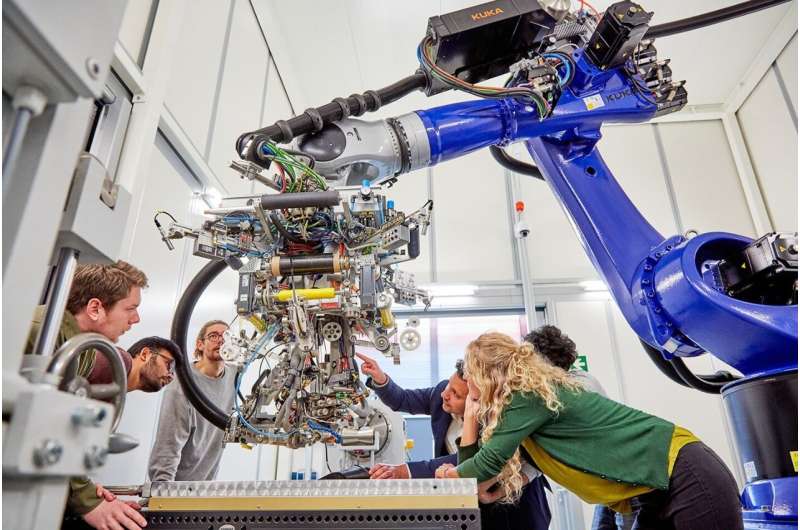Reducing climate-damaging emissions with lightweight drive shafts

Lightweight design is essential for sustainable mobility. Drive shafts made of carbon-fiber-reinforced plastics (CFRP) with a thermosetting matrix, for example, can reduce climate-damaging emissions. Nevertheless, the lightweight design and resource-saving potential of these shafts has not been completely realized yet.
Together with partners, researchers at the Fraunhofer Institute for Applied Polymer Research IAP are developing a new, very lightweight drive and side shaft system for cars and trucks whose matrix consists of thermoplastic materials. These materials can be recycled and have an additional weight advantage.
Significant efforts are required in mobility to reduce climate-damaging emissions further. Drive shafts made of fiber-reinforced plastics can reduce the fuel consumption of vehicles through their low weight and thereby help to lower the environmental impact. In cars and trucks, they transfer the power from the gearbox to the wheels and have to withstand high loads in the process. For this reason, they are usually manufactured as multi-piece drive shafts and made of heavy materials such as steel, aluminum or titanium alloy.
Current alternatives are drive shafts made of carbon-fiber-reinforced plastic with a thermosetting matrix. As a result of their lower density and fewer required bearing positions, they are around 60 percent lighter than their metal counterparts and feature better mechanical properties. Yet they can still be further optimized in terms of weight and ease of recycling.
Researchers of the Fraunhofer project group “Center for Sustainable Lightweight Technologies” (ZenaLeb), a project group of the research division Polymeric Materials and Composites PYCO at Fraunhofer IAP, together with partners from industry, are dedicated to this task. “In the first step, we want to optimize wound drive and side shafts with a thermosetting matrix. In the second step, we will develop shafts with a thermoplastic matrix,” Felix Kuke, head of ZenaLeb, summarizes the approach.
Reducing fuel consumption and CO2 emissions
Drive shafts with a thermosetting matrix are currently produced using filament winding. In this manufacturing process, filaments impregnated with resin are wound around a rotating axis under tension and cured in a further step. The planned thermoplastic drive and side shafts, however, will be manufactured using automated fiber placement technology (AFP).
“With AFP technology, prepregs, i.e., pre-impregnated tapes that contain carbon fibers, are heated by a laser and then placed on a rotating axis fully automatically and controlled by a robot. Additional curing is not necessary,” explains the researcher.
Further advantages of AFP technology: The tapes can be cut during the process and placed at different positions to create new angles, winding patterns and shapes. In other words, the drive shafts can be wound freely and are not limited by predefined winding patterns, as opposed to filament winding. This results in a lower weight compared to current thermosetting design methods. According to calculations by
Fraunhofer IAP, the new design can lower fuel consumption by 0.3 percent during the use phase and considerably reduce CO2 emissions for newly registered cars and trucks in Germany. In comparison to steel-based drive shafts, it is even possible to achieve weight savings of more than 65 percent. “The AFP process allows manufacturers to achieve high productivity rates. Our goal is to implement the manufacturing concept for large-scale production,” explains Kuke.
Digital monitoring of the entire product life cycle
Tracking the complete process chain to reduce the carbon footprint requires the product life cycle—from the production of the base material to recycling—to be mapped and monitored using integrated sensor systems. For this purpose, fiber-optic sensors and strain gages are wound into the drive shafts and the plants equipped correspondingly.
The prepregs already feature a QR code that provides information on the fibers as well as the matrix system used, which is essential for recycling. By integrating product branding concepts and sensor systems, it is possible to assess the environmental impact of the production of the new shafts and to determine the required energy and resource consumption.
Digitization and simulation tools in the form of a digital twin support the optimization process as well as quality assurance and help to make the design more lightweight. “Suitable digitization tools allow us to calculate entire assemblies,” says the researcher.
Citation:
Reducing climate-damaging emissions with lightweight drive shafts (2023, June 1)
retrieved 1 June 2023
from https://techxplore.com/news/2023-06-climate-damaging-emissions-lightweight-shafts.html
This document is subject to copyright. Apart from any fair dealing for the purpose of private study or research, no
part may be reproduced without the written permission. The content is provided for information purposes only.
For all the latest Technology News Click Here
For the latest news and updates, follow us on Google News.
